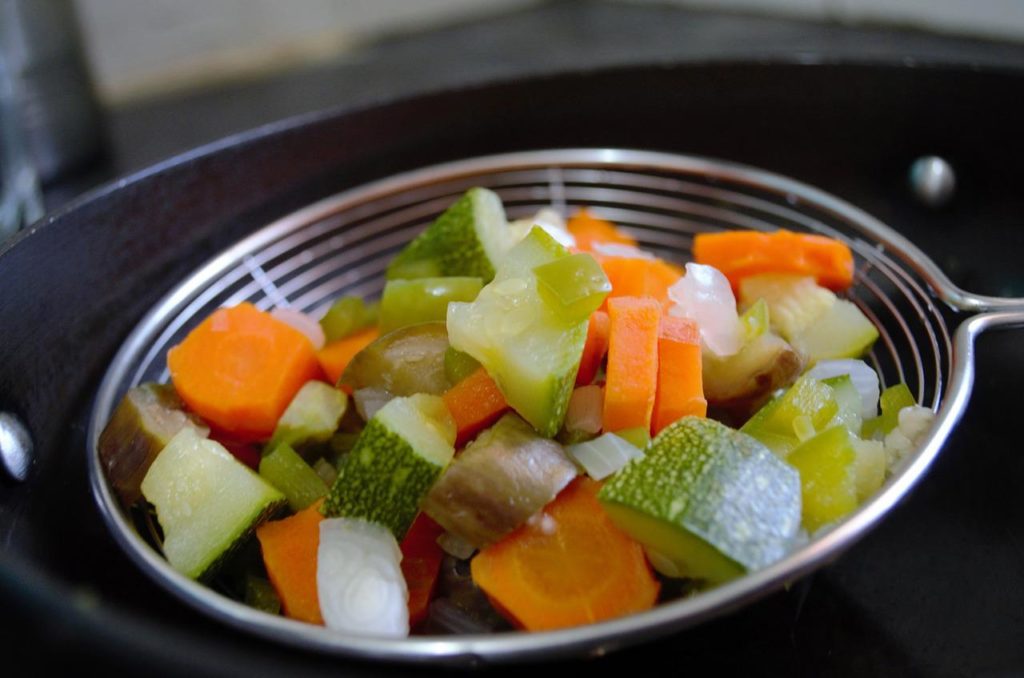Are you aware of the tricks to blanching vegetables? If done correctly, it keeps the vegetables fresh for longer in the refrigerator. You can learn the process here very quickly.
Contents
Blanching vegetables

Blanching the vegetables is indeed a very important factor. Many well-known chefs and cooking experts too stress on the fact of blanching the vegetables well. But, do you the reason why? Blanching vegetables happen to be the process that has been recommended as a pre-treatment before you freeze them. When you blanch the vegetables before freezing, they stay fresh for a longer time.
Without blanching, the vegetables tend to lose a part of their original color, texture, and taste after you freeze them. The main purpose of blanching is to counteract the changes in the vegetables by neutralizing their enzymes. It is due to this factor that the changes occur in vegetables. So, blanching indeed helps the vegetables to retain their quality after freezing. Although it is not necessary to do but surely in doing so, you get better results in the end.
There are three stages to the process of blanching. First is to pre-heat the water. Then you blanch the vegetables. And then you cool them. So, at first, put the water for blanching to boil. Then you put the vegetables inside the boiling water or can even steam it for a short while. And then finally you cool them quickly so that it does not get cooked. In the case of vegetables, the quickest and the most common method of blanching is just to put them in boiling water to blanch. This guide speaks about the exact process of doing so.
But you can also feel free to steam the vegetables if you wish. But the only thing is to make sure that you are steaming them for a longer duration. In the case of steaming the vegetables, you must keep them 2-3 times longer than you would normally keep them for blanching. Here you must also make a note of the fact that blanching is only done when you are freezing the vegetables raw. In case if you are cooking or baking the vegetables before freezing, then, in that case, you must not blanch them.
The process to blanch vegetables before freezing
- Prepare the vegetables first, and make them ready for being used immediately after thawing.
- Put a pot of water in the oven to boil.
- As the water is being heated, make arrangements to give the vegetables an ice bath. Fill a large pot of water and put in it some ice cubes, if you are carrying it. Remember to avoid doing this process with ice cubes if it is only a handful of vegetables that you are blanching.
- As soon as the water in the pot starts to boil, put the prepared vegetables in the pot. Now put the lid over it and allow the water to boil again.
- When the water starts to boil one more time, set a timer and let the vegetables boil as per the time set on the timer. The timer that you have set for boiling the vegetables depends upon a number of factors. The type of vegetable you are blanching, its size, the cut, and also its texture as well. usually, it is about a minute for the leafy green vegetables. And for about 8-10 minutes if it is whole corn over the cob.
- As soon as you reach the time set on the timer, immediately put the vegetables for an ice bath in another container.
- Now allow the vegetables to swim in the cold water for about five minutes at least.
- Pick them up and dry them thoroughly. Although drying is not a process of blanching but, the vegetables must be completely dry before being put to freezing. Shaking the vegetables also brings out the water from them. It is indeed a useful technique. Now assemble all the blanched vegetables over a dishcloth. Let them dry for about thirty minutes. But before you move any further, get a paper towel and give the vegetables a gentle rum and dry them completely. And thus, you are sorted.
Tips and tricks for blanching the vegetables
- In place of a large pot, you can even use the sink for giving the vegetables an ice bath.
- If you are having a big batch of vegetables to blanch, you do not need to put them all at once in the boiling water. You can follow the process in batches as well. in such a scenario, remember to boil the water each time. And must also remember to give an ice bath to each batch individually. Make sure to keep the ice bath cool or else you can pour ice water as well after being given them an ice bath.
Why is it necessary to blanch vegetables?

As you have known by now, there are many vegetables like carrots, asparagus, and peas that benefit from this process. When you blanch them before freezing, it shall retain their color. In addition to this, there are more reasons for it as well.
- As you blanch, it loosens the skin of certain vegetables. Blanching makes tomatoes and peas easier to peel.
- Blanching slows down the process of enzymes as you are freezing. This brings a loss in its color, texture, and flavor as well.
- Through the process of blanching, the surface of the vegetables gets cleaned. It removes the organisms and dirt and in certain cases removes the bitterness as well.
- Blanching brightens the color of certain vegetables such as broccoli. This turns more appetizing than raw vegetables.
- Through the process of blanching the loss of nutrients from the vegetable gets slowed down.
- Vegetables that take longer to get cooked can be blanched before you put them for grilling. They get cooked much quicker.
Time taken by vegetables for blanching
Although not all vegetables require blanching but the most common ones that benefit from blanching are:
- Asparagus
Small asparagus spears take two minutes to blanch while it takes three minutes for medium spears. It is four minutes for the large spears.
- Broccoli
To blanch small florets of broccoli takes three minutes. It should turn bright green but hardly tender.
- Carrots
To blanch, a whole carrot takes five minutes. If the carrots are chopped then it takes two minutes.
- Beans (Italian, snap, green, and wax)
If in batches then small beans take two minutes. It takes three minutes for medium and four minutes for large beans.
- Peas (English and green, both)
It takes only a minute and a half for it to blanch.
The process to blanch vegetables before freezing (using the microwave)
- Put the fruits or vegetables forming a single layer in a dish suitable for the microwave.
- Add one-fourth to half a cup of water to the dish.
- Now cover that and put the microwave on high. The time recommended for this is about half an hour. now uncover and stir and let the cooking get over.
- Stir again and quickly put it in an ice bath.
- After the fruit or the vegetable cools down, drain the water and set it aside ready to be cooked or to freeze.
The process of cooling
You must remember that even after the vegetable has been taken off from fire, it still continues to cook. The process of putting the vegetable directly into the ice water bath is called as shocking. It brings a sudden halt to the process of cooking and its effects.
Ice water is the best agent because it cools quickly. Even a few ice cubes bring in a difference. Although tap water may not be a perfect option but, you can still make it work if there is no ice water.
You must also never leave the vegetables in the ice water for a longer duration. It shall make them soggy. This is the reason why as soon as the vegetables get cool, you dry them immediately. This process of drying the vegetables is extremely important. It stops it from turning soft and also does not add moisture to the recipe.
Other than vegetables and fruits what else can be blanched?
Apart from fruits and vegetables, there are other things such as certain types of almond recipes that benefit from blanching. For almond cookies and marzipan, there is blanching needed to be done to the nuts. It helps to remove their skins. Blanching also prevents the skin of the avocado from turning brown.
When you prepare homemade broth from the bones, blanching the bones removes their impurities. While making French fries you can even blanch the potatoes. It cuts away their fat. So, as you have seen here, blanching is indeed a very important process no matter if you are freezing or not. It proves to be beneficial in so many ways.





